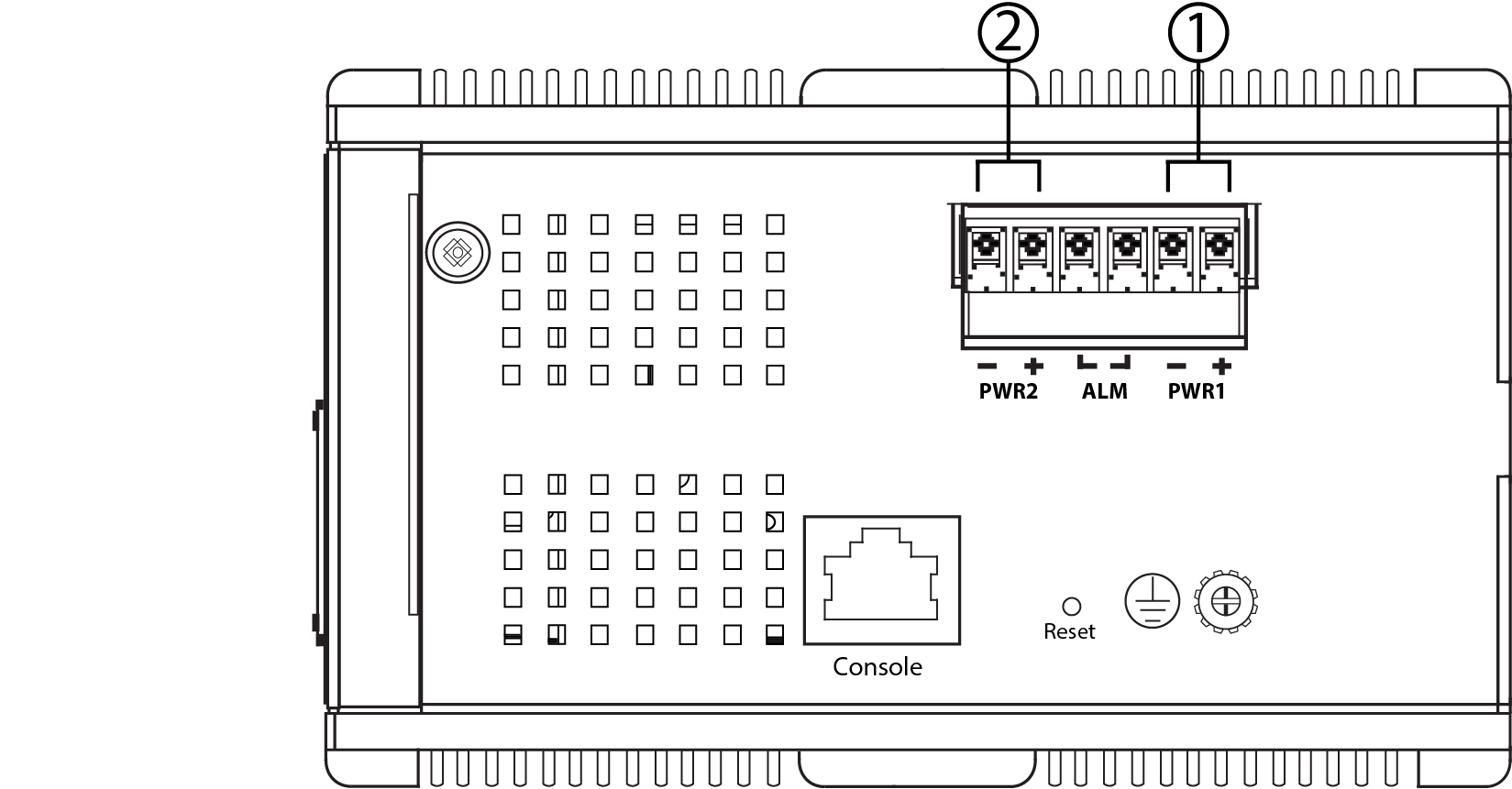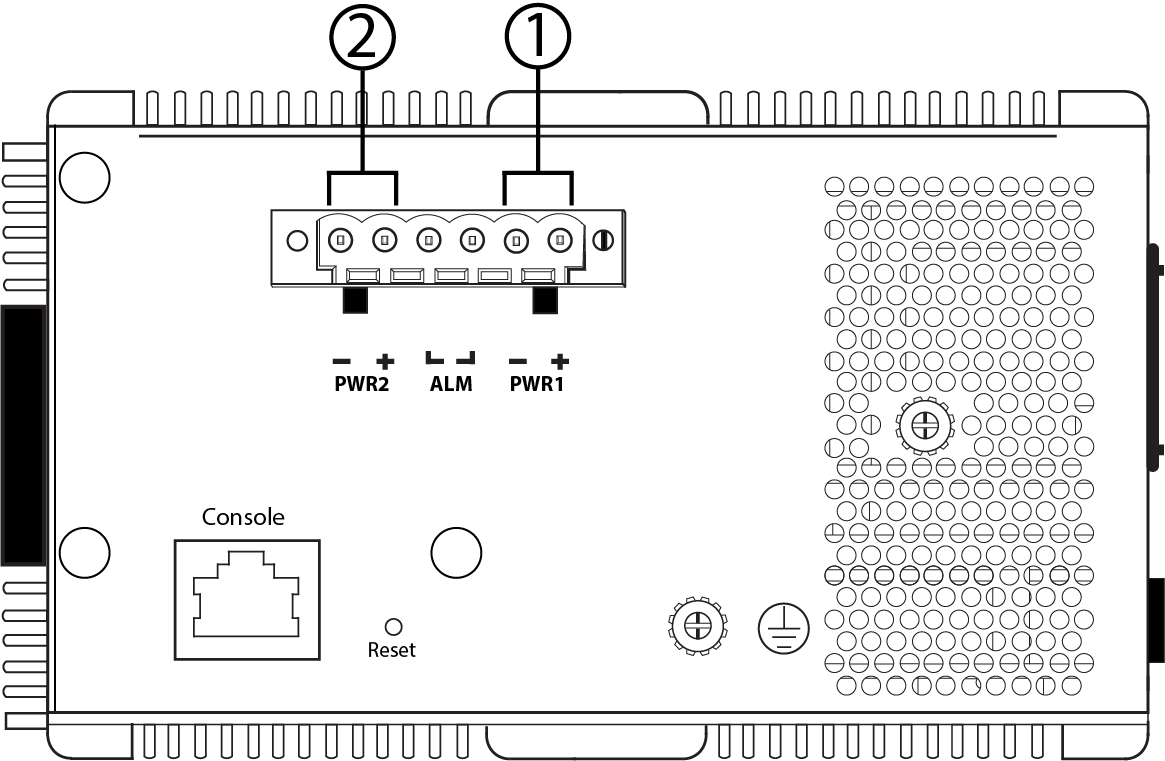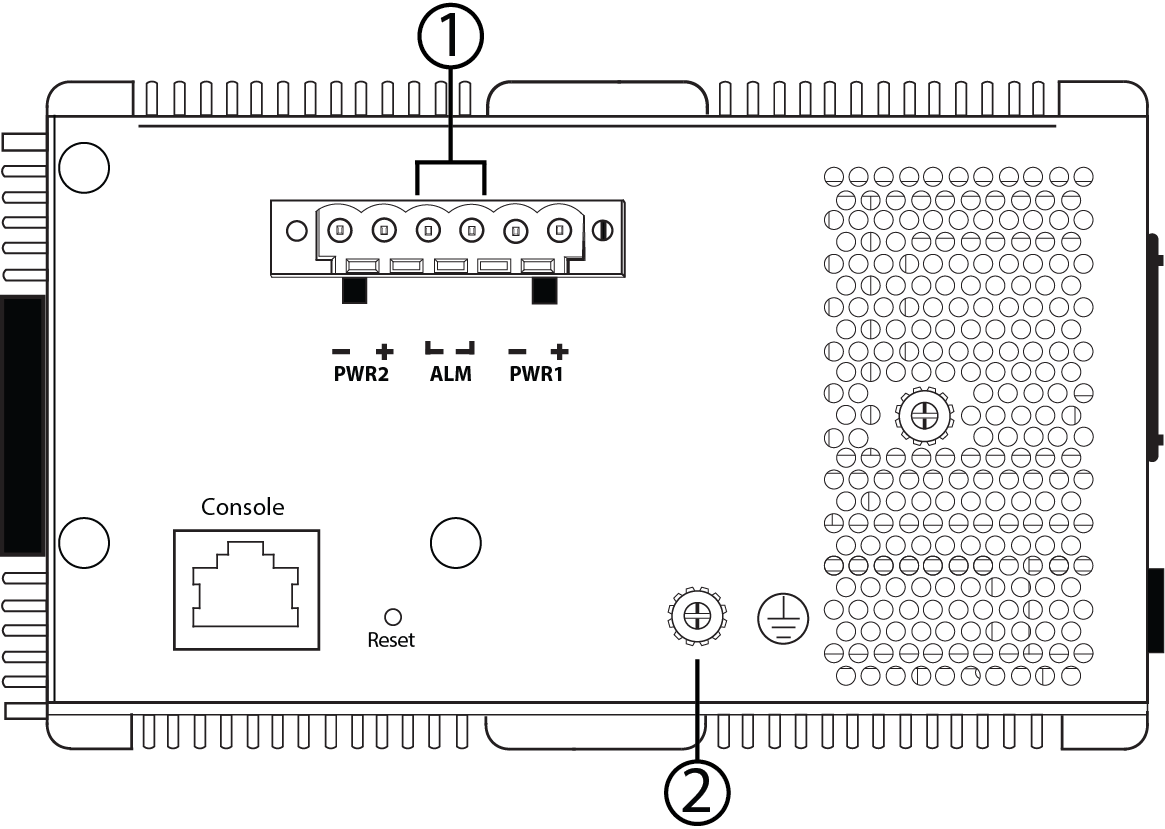Connect Power Supplies, Alarm Relay, and Ground Connection
Use the following sections to connect the power supplies, alarm relay, and ground connection.
Connect the Power Supplies to a Power Source
The power supplies connect to an AC power source and convert the AC current to DC current for the switch to use. The power supplies are redundant; two 240W power supplies do not provide 480W, they only provide 240W. The power supplies must be installed by qualified personnel such as licensed electricians, in accordance with local electrical codes, and connected to a well fused power source.

Warning
Electrical Hazard: Only qualified personnel should perform installation procedures and field wiring to AC primary voltage source
Warning
Electrical Hazard: Risk of electrical shock and energy hazard. All failures should be examined by a qualified technician. Do not remove the case of the power supply by yourself
Warning
Electrical Hazard: Risk of electric arcs and electric shock (danger to life). Connecting both the primary and the secondary sides together is not allowed.
Warning
Do not install the unit in places with high moisture or near water.
Warning
The Frame Ground (FG) must be connected to PE (Protective Earth).
Warning
Before commencing any installation, maintenance, or modification work, disconnect your system from supply voltage. Make sure that inadvertent connection in circuit will be impossible!
Warning
Always enable good ventilation clearances: 5mm left and right, 40 mm above, and 20 mm below the unit in use to prevent it from overheating. Also a 10-15 cm clearance must be kept when the adjacent device is a heat source
Warning
The appropriate mounting orientation for the unit is vertical, the input terminals at the bottom and output on the top. Mounting orientations other than that, such as upside down, horizontal, or table-top mounting, is not allowed.
Warning
To reduce risk of accidental shock or burn, install PSU in a Restricted Access Location. A Restricted Access Location is a location for equipment where both of the following apply:- Access can only be gained by SERVICE PERSONS or by USERS who have been instructed about the reasons for the restrictions applied to the location and about any precautions that shall be taken.
- Access is through the use of a TOOL or lock and key, or other means of security, and is controlled by the authority responsible for the location.

Warning
For continued protection against risk of fire, replace only with same type and rating of fuse.Pour ne pas compromettre la protection contre les risqué d‘incendie, remplacer par un fusible de même type et de memes caractéristiques nominales.
- Use copper wire only. The
following table shows recommended wires.
18 16 14 12 10 Rated Current of Equipment (Amp) 6A 6-10A 13-16A 16-25A 25-32A Cross-section of Lead (mm2) .75 1.0 1.5 2.5 4 
Note
- Current each wire carries should be de-rated to 80% of the current suggested abovewhen using 5 or more wires connected to the unit.
- The maximum allowable wire cross-sectional area for the terminal of the SDR-75 is12AWG/2.5 mm2.
- Make sure that all strands of
each stranded wire enter the terminal connection and the screwterminals are
securely fixed to prevent poor contact.
If the power supply possesses multi-output terminals, make sure each contact is connected to wiresto prevent too much current stress on a single contact.
- Use wires that can withstand temperatures of at least 80°C, such as UL1007.
- The recommended screwdriver
is 4mm, slotted type. The recommended torque setting for terminals is shown
in in the table below.
Model I/P O/P SDR-240 / 480 5 kgf-cm (4.4 lb-in) 8 kgf-cm (7 lb-in) - The suggested fuse and
maximum number of the SDR PSUs that can be connected to a circuit breaker at
230V are shown in the following table.
Model Fuse Circuit Breaker C16 D16 SDR-240 T5A/L250V 4 8 SDR-480 T8A/L250V 4 4 - Verify that the power source circuit is de-energized.
- Connect the power source to the AC input terminals on the power supplies.
See Power Supply AC
and DC inputs for the AC input terminal location on the power
supply.Power Supply AC and DC inputs

1 = AC terminal input from power source 2 = DC terminal output to DC switch terminal input - Continue to Connect Power Supplies to the Switch.
Connect Power Supplies to the Switch
The following AC-DC power supplies (PSUs) are available for the ISW-Series switches:
- 240 W AC-DC PSU
- Part number 16807 is compatible with all ISW-Series switch models.
- 480 W AC-DC PSU
- Part number 16920 is compatible with all ISW-Series switch models.
The AC-DC power interface is a 6-pin terminal block with polarity signs on the top panel on most of the ISW-Series switches. The 6-pin terminal block contains an alarm contact in the middle of the terminal block. The power interface for the ISW 24GbP, 4-SFP model switch is a 4-pin terminal block with polarity signs on the rear panel.
Use the following steps to install the power supplies:
- Verify that the power source circuit is de-energized.
- Connect the DC output terminals
on the power supply to the DC input terminals on the switch. Insert the positive
and negative wires into V+ and V- contacts on the terminal block respectively
and tighten the wire-clamp screws to prevent the wires from being
loosened.
See Power Supply AC and DC inputs for the location of the DC output terminals on the power supply. See the following illustrations for the location of the DC terminal inputs on the switch.
- Energize the power source circuit.
- When power is connected, verify that the switch‘s PWR LED turns green. If the PWR LED does not turn green, refer to System Status LEDs for troubleshooting information.

Note
Connect the AC-DC power supply to a well-fused power source.


| 1 = First power supply | 2 = Second power supply |
- Mount only as shown in the
figure below, with input terminals down so that sufficient cooling is
possible.Rail Fastening Orientation

- Tilt the unit slightly rearwards.
- Fit the unit over top hat rail.
- Slide it downward until it hits the stop and press against the bottom to lock it in place.
- Shake the unit slightly to check the locking action.
Connect the Alarm Relay and Ground Connection
The alarm relay output contacts are in the middle of the DC terminal block connector as shown below.
The alarm relay out is “Normal Open,” and it closes when any predefined failure such as a power failure or an Ethernet link failure is detected.
The relay output with current carrying capacity of 0.5A @ 24 VDC.




| 1 = Alarm relay connection | 2 = Earth ground connector |
To connect the ground connection:
- Locate the grounding point at the rear of the chassis, which is marked by the
international symbol for earth ground.

- Strip the insulation to expose 1/2 inch (12 mm) of bare wire at one end of the grounding wire.
- Wrap the bare grounding wire around the provided M3 or M4 earth ground screw.
- Use a straight-tip torque screwdriver to tighten the retaining screw to 20 in‑lb (2.25 N m).
- Connect the other end of the grounding wire to a known reliable earth ground point at your site.

